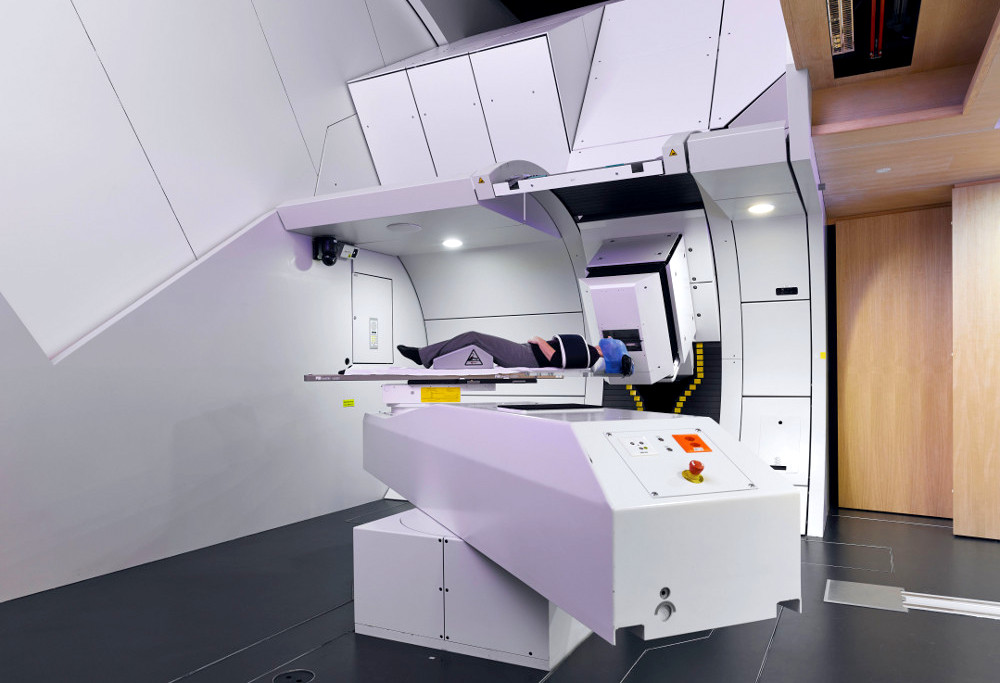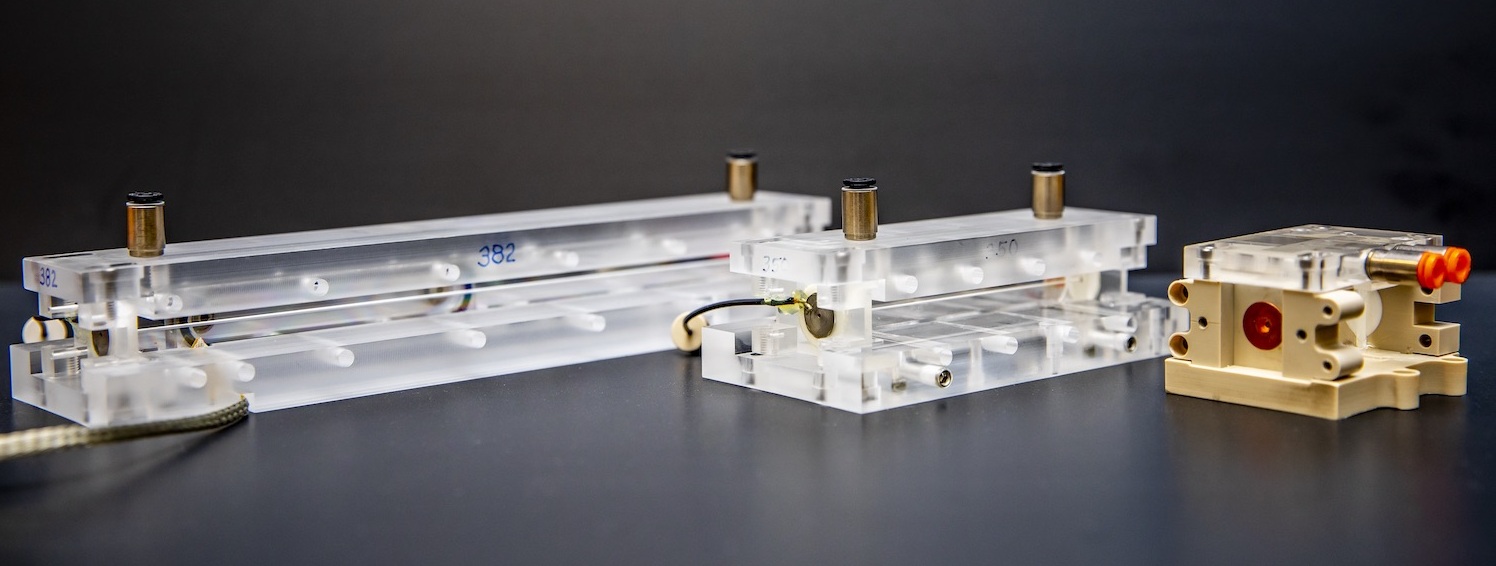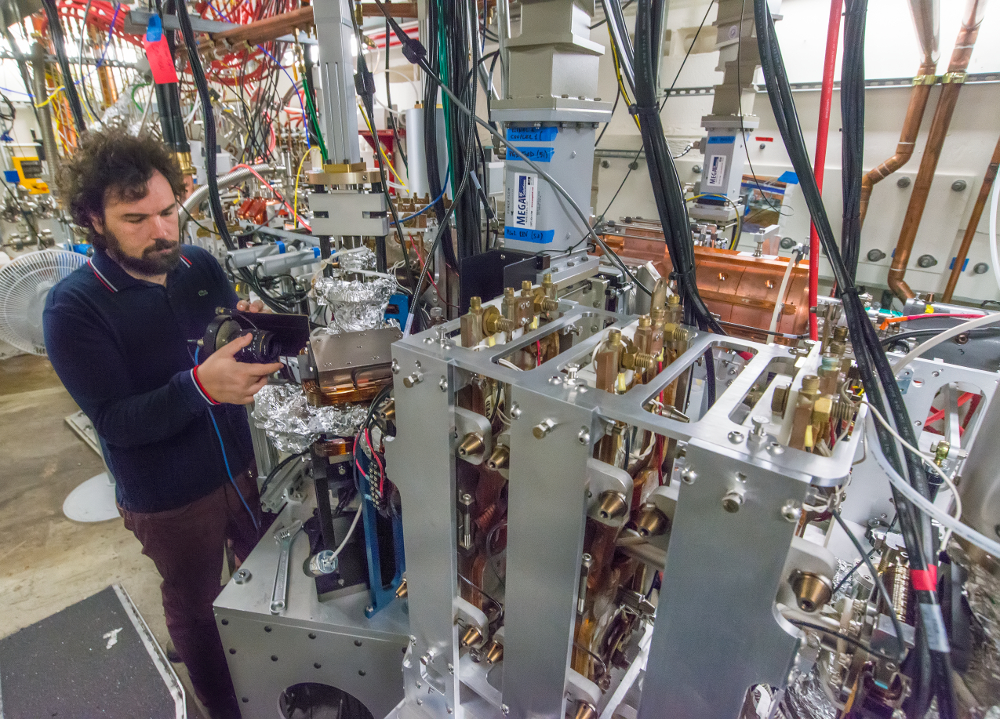U.S. Department of Energy awards announced in July will advance Lawrence Berkeley National Laboratory (Berkeley Lab) R&D to develop a more effective and compact particle-beam system for cancer treatment, improve particle-beam performance using artificial intelligence, and develop a high-power, rapid-fire laser system for both tabletop and large-scale applications.
In total, the DOE Accelerator Stewardship awards will support 12 research projects – involving scientists at 10 national labs, eight universities, and five companies – with $12 million to develop particle accelerator technologies for a range of applications via the Accelerator Stewardship program, which DOE coordinates with several other federal agencies.
The Berkeley Lab R&D efforts supported by the stewardship awards are led or co-led by scientists in its Accelerator Technology and Applied Physics Division (ATAP).
Magnet system enables better beams for cancer-fighting therapy

Proton-beam therapy at the Paul Scherrer Institute in Switzerland. Berkeley Lab is working with PSI and Varian Medical Systems to develop a new system with improved beam performance. (Credit: Center for Proton Therapy/PSI)
The cancer-treatment award furthers Berkeley Lab work to develop superconducting magnet technologies aimed at reducing the cost and size of proton-beam therapy systems. Proton-beam therapy, first developed at Berkeley Lab and first tested for cancer treatment using the Lab’s 184-inch cyclotron particle accelerator in 1954, can deliver highly targeted doses of radiation to cancerous tumors while reducing the damage to healthy surrounding tissue compared to alternative types of beam therapies.
Lucas Brouwer, a scientist at Berkeley Lab who began working on this R&D effort as a postdoctoral researcher in 2015, is teamed with industry partner Varian Medical Systems and the Center for Proton Therapy at Switzerland’s Paul Scherrer Institute (PSI), which is actively treating patients.
Brouwer noted that Berkeley Lab’s work on this next-gen magnet technology for proton-beam therapy began a decade ago with support from the Laboratory Directed Research and Development (LDRD) program, through which Berkeley Lab supports specific areas of research. Berkeley Lab’s David Robin led the original LDRD-funded research, and Soren Prestemon, also of Berkeley Lab, led the continuation of this effort via the Accelerator Stewardship program.
Varian has unique capabilities in delivering technology solutions for state-of-the-art proton therapy, Brouwer noted, and PSI has experience with operating an advanced proton therapy facility and designing the gantry, which is the rotating structure that delivers the beam to patients. Varian and PSI will provide guidance on the technical requirements for beam delivery systems, and clinical criteria for treatment. In addition, Varian will assist in developing magnet technology suitable for future commercialization.
The new award, which amounts to $1.6 million over three years, will be used to build a superconducting magnet system that can deliver a beam with highly controllable, rapidly changing energy levels.
“During treatment, it is desirable to change the beam energy quickly to scan the tumor depth,” Brouwer explained.
For existing systems of superconducting magnets, these quick energy changes necessitate changes in the magnetic field strength, which can generate heat. These deposits of heat are particularly challenging for superconducting magnets, which must be cooled to hundreds of degrees below freezing.
To overcome this, researchers hope to develop superconducting magnet technology that can accept the full range of beam energies required for treatment without any change in the magnetic field strength.
“Our past work achieved a 10 times reduction in the need for magnetic field change when compared to current systems,” Brouwer said, which was accomplished by a beam optics system that delivers beams over a wide energy range without requiring a change in the strength of the magnets.
The new system should enable treatment methods such as “breath-hold pencil scanning and ultrafast FLASH treatment, both of which show great promise to reduce unwanted damage to healthy tissue,” Brouwer added. The new system is also intended to be more robust and cost-effective than existing systems, and to deliver doses much faster than existing systems, which could improve outcomes for cancer patients.
In addition to testing the effectiveness of the technology, the research team expects to construct a full-scale prototype magnet.
Rapid-fire laser tech for next-gen colliders, tabletop accelerators

Different generations of sapphire tubes, called capillaries, are pictured here. The tubes are used to generate and confine plasmas, and to accelerate electrons. A 20-centimeter capillary setup, similar to the one used in record-setting laser plasma acceleration experiments at Berkeley Lab’s BELLA Center, is pictured at left. (Credit: Marilyn Chung/Berkeley Lab)
Another project will advance R&D for a new type of laser system that can deliver high-peak-power, high-repetition-rate laser pulses at very high efficiency by combining multiple ultrashort-pulse beams produced by an array of optical fiber lasers.
The effort, led by researchers from Berkeley Lab, the University of Michigan, and Lawrence Livermore National Laboratory (Livermore Lab), will receive $3.08 million over three years.
The effort is the exciting next step that builds on work earlier supported by Accelerator Stewardship funding from 2015 to 2020.
The goal is to demonstrate that the laser technology can be scaled up to drive particle colliders with a new method of particle acceleration known as laser-plasma acceleration, and whether it could also support tabletop systems for a variety of applications. The technology is designed to deliver orders of magnitude higher average power and much higher efficiency than today’s ultrashort pulse lasers.
Berkeley Lab is a leader in laser-plasma accelerator R&D, and the Stewardship Program award will aid Berkeley Lab’s efforts to develop future lasers to drive this technology to meet application needs, including kBELLA, a high-repetition-rate facility to advance laser-plasma accelerator R&D.
In laser-plasma acceleration, laser beams deliver a heavy kick to an exotic, superhot state of matter known as a plasma that drives electrons associated with the plasma to ride on the crest of a rapid plasma wave, like a surfer. The method produces a huge surge in acceleration over a very short distance compared to conventional electron accelerators.
Over the next three years the research teams will build an arrayed fiber laser system capable of firing pulses at a rate of up to 10,000 per second that are each about 100 femtoseconds, or quadrillionths of a second, in duration, with an energy of about 100 millijoule per pulse.
“The upcoming work is based on our significant progress in fiber-laser combination, and will push these methods forward while developing technical designs for systems meeting the needs of plasma-accelerator applications,” said Russell Wilcox, a staff scientist in the ATAP Division who has been a leading innovator in this area.
Berkeley Lab and University of Michigan researchers will focus on how to efficiently combine multiple fiber lasers to reach high energies and high repetition rates, and the Livermore Lab team will focus on improving specific pulse properties. Other Berkeley Lab scientists supporting the effort include Tong Zhou, Qiang Du, Eric Esarey, and Derun Li.
Cameron Geddes, a senior scientist in the Berkeley Laboratory Laser Accelerator (BELLA) Center and principal investigator for the effort, said, “The work will be a key step toward next-gen high-energy particle colliders and accelerators based on laser-plasma accelerator technology, and we will lay the foundation for scaling to very high power and particle energies.”
Improving particle accelerator performance with artificial intelligence

Daniele Filippetto, a Berkeley Lab scientist, works on the High-Repetition-rate Electron Scattering apparatus (HiRES), which functions like an ultrafast electron camera. A new R&D program will use HiRES to test out a machine-learning system that could improve particle-beam performance. (Credit: Roy Kaltschmidt/Berkeley Lab)
Another stewardship award-supported project seeks to develop machine-learning-based systems that can improve the performance of a wide range of compact accelerators via auto-tuning. The project will test out machine-learning algorithms on two accelerators at Berkeley Lab – HiRES, the High Repetition-rate Electron Scattering Apparatus, which produces highly focused electron bunches at very high repetition rates and can function like an ultrafast electron camera; and NDCX-II, which produces intense ion beam pulses.
The project will be led by Alexander Scheinker, an accelerator R&D engineer at Los Alamos National Laboratory. Berkeley Lab’s Daniele Filippetto, a staff scientist who leads HiRES experiments, and Qing Ji, a staff scientist who will oversee the NDCX-II effort, are co-principal investigators. Berkeley Lab scientists will receive $148,000 per year for three years.
Scheinker will lead the development and implementation of the adaptive machine-learning algorithms that can provide optimal controls for multivariable time varying systems, and Filippetto and Ji will coordinate with him to provide the necessary data from beam tests and simulations.
Filippetto noted that rather than focusing the machine-learning algorithm on one control parameter of an accelerator, this effort will encompass the entire machine and all of its operating parameters at once.
“The idea is that we want to try to develop new, adaptive algorithms – known as global adaptive feedback systems – that optimize accelerator performance by looking at and tuning all of the variables of a system together,” he said, adding, “We’re trying to look at the entire accelerator having a holistic approach – to look at how all of the parameters are varying with time, and find hidden correlations.”
Ultimately, an effective machine-learning system linked to the accelerator controls could help pinpoint the exact arrival time of each electron beam pulse on a sample. Or the machine-learning algorithm could aid in seamlessly switching between operating modes and sample types, he said, by performing live, automatic optimization of the beam for each configuration. “You may have different samples that require different beam parameters, and you could switch between one sample and the other by pushing a button.”
HiRES is a research tool for ultrafast electron diffraction, which is useful for studying chemical reactions, electronic or superconducting properties in materials, or defects and their effects in materials, for example.
“Our primary goal is to get the best resolution possible,” he said, which requires a stable, highly focused beam, measuring just a few billionths of a meter in diameter and hundreds of quadrillionths of a second in time. Filippetto said his group has already been working to build a model using neural networks – an artificial intelligence technique – to simulate the HiRES beam, which should be useful in helping to train a machine-learning algorithm.
Ji noted that WARP, a code developed by Berkeley Lab and Livermore Lab researchers, was used during the physics design of NDCX-II, and has been helpful in understanding the beam characteristics and in tuning the ion beam at NDCX-II. WARP simulations of the NDCX-II beam, and other diagnostic data from the accelerator operation, will be used in training the machine-learning algorithm, she noted. “There are at least 40 parameters we can change” in NDCX-II, she said, which provides an ideal platform to validate the machine-learning algorithm.
“Once we have everything trained, we’ll see if we can use this to find a better set of parameters to reach higher intensity and shorter pulses,” she said. “We want to deliver as many ions on the target as possible, with a pulse duration on the order of just a few nanoseconds, while focusing the beam down to spot size about 1 millimeter or less in diameter.”
Thomas Schenkel, ATAP’s interim division director, said, “These efforts exemplify the importance of Accelerator Stewardship.” He added, “The program supports foundational work whose benefits will be leveraged in many fields, and also applications that turn accelerator science and technology into benefits to society.”
More:
VIDEO: Particle Accelerators Drive Decades of Discoveries at Berkeley Lab and Beyond
###
Founded in 1931 on the belief that the biggest scientific challenges are best addressed by teams, Lawrence Berkeley National Laboratory and its scientists have been recognized with 13 Nobel Prizes. Today, Berkeley Lab researchers develop sustainable energy and environmental solutions, create useful new materials, advance the frontiers of computing, and probe the mysteries of life, matter, and the universe. Scientists from around the world rely on the Lab’s facilities for their own discovery science. Berkeley Lab is a multiprogram national laboratory, managed by the University of California for the U.S. Department of Energy’s Office of Science.
DOE’s Office of Science is the single largest supporter of basic research in the physical sciences in the United States, and is working to address some of the most pressing challenges of our time. For more information, please visit energy.gov/science.